How to Implement Zero Trust? A Complete Guide
It’s 2:07 a.m. when your notifications explode. VPN dashboards show “all green,” but your SIEM tells a different story—impossible logins, token reuse, and privilege escalation unfolding in real time. You cut sessions, yet the lateral movement is already happening. This is where perimeter-based security collapses.
Below, you'll find a practical guide to Zero Trust implementation—detailing how to verify every access request in real time, validate device health before connections are allowed, and segment traffic paths to eliminate lateral movement.
The outcome? A security model where a single compromised credential doesn’t bring down your enterprise.
Key Takeaways
- Zero Trust replaces perimeter trust with continuous verification: Every access request, device, and workload is authenticated in real time, preventing lateral movement even if credentials are stolen.
- Implementation requires phased adoption: Start with high-risk assets, map transaction flows, and expand systematically to avoid disruption while achieving early wins.
- Identity and device health are non-negotiable: Phishing-resistant MFA, conditional access, and endpoint posture checks form the foundation of Zero Trust security implementation.
- Backup resilience is part of Zero Trust: Segmentation, immutability, and the 3-2-1-1-0 backup rule ensure that backups remain recoverable even when production environments are breached.
- Purpose-built target backup appliances outperform integrated solutions: ESG survey data shows they align better with Zero Trust architecture implementation, providing faster recovery and stronger ransomware protection.
What Is Zero Trust Implementation?
Zero Trust implementation is the process of designing and enforcing a security model where no user, device, or workload is implicitly trusted and every access request must be verified continuously, regardless of location or network.
It builds on the principles outlined in NIST SP 800-207 and expands them into practical controls across identity, devices, networks, applications, and data.
In practice, this means going beyond firewalls and VPNs to map networks and transaction flows to verify endpoints before granting access, monitor traffic patterns in real time, and apply dynamic policies that adapt to context.
The benefits of Zero Trust security implementation include:
- Reduced breach risk and lateral movement through continuous verification and microsegmentation.
- Improved regulatory compliance and easier audit readiness by enforcing provable controls.
- Better visibility and control over identities, devices, and workloads.
- Enhanced cyber resilience and stronger ransomware protection.
Zero Trust Architecture (ZTA) vs Zero Trust Network Access (ZTNA)
When planning a Zero Trust architecture implementation, the first step is distinguishing between the architecture itself and the access solution built on top of it.
- Zero Trust Architecture (ZTA) is the framework that enforces strict authentication, continuous authorization, and segmentation across the enterprise, replacing perimeter-based trust with per-request policy controls.
- Zero Trust Network Access (ZTNA) is a ZTA use case that secures app and data access from any user, device, or location, replacing VPNs with context-aware, least-privilege sessions.
The table below highlights how ZTA and ZTNA play different but complementary roles.
| Zero Trust Architecture (ZTA) | Zero Trust Network Access (ZTNA) | |
| Scope | Enterprise-wide design covering identity, devices, apps, workloads, and data | A specific control enforcing secure, least-privilege access to apps and data |
| Goal | Replace implicit trust with continuous verification across all layers | Replace VPNs and perimeter-based access with context-aware, per-session connections |
| Implementation | Built on NIST SP 800-207 principles: policy engine, enforcement points, microsegmentation, continuous monitoring | Delivered as a solution (on-prem or cloud) that enforces policies for users and workloads accessing specific resources |
| Use Cases | Regulatory compliance, ransomware resilience, unified security strategy | Secure remote work, multi-cloud access, contractor/partner access |
| Relationship | Provides the architecture and policies that make ZTNA possible | Operates within ZTA as a practical access control mechanism |
Implementation Principles and Best Practices
Zero Trust is rapidly becoming the leading data security model for governments and enterprises worldwide. Unlike legacy perimeter defenses, it applies equally to on-premises, cloud, and hybrid environments—regardless of company size or industry.
Before diving into tools or roadmaps, IT teams must understand the core principles that guide every Zero Trust security implementation best practice.
- Assume Breach: Design every control as if attackers are already inside your environment. This means limiting the blast radius with microsegmentation but equally ensuring recovery readiness with immutable backups, tested restores, and scripted playbooks so operations continue even under compromise.
- Don’t Implicitly Trust: Every request—user, device, or workload—must be validated. Go beyond MFA by enforcing context-aware policies that check device posture (patch level, EDR status, encryption) and location (trusted office IPs vs. unusual geographies), blocking access when either fails policy.
- Apply Least-Privilege Access: Give users and workloads only the minimum access needed. Use Just-In-Time (JIT) access to grant temporary, task-specific permissions and Just-Enough Access (JEA) to further reduce exposure, eliminating standing privileges that attackers can exploit.
10 Steps to Implementing Zero Trust
Adopting Zero Trust doesn't happen overnight. A phased adoption strategy is what's really needed to reduce complexity, demonstrate early wins, and gain stakeholder support.
It's best to start by securing a small, high-risk segment—such as privileged access to sensitive systems—and then expand step by step until the entire enterprise operates under Zero Trust principles.
Below you'll find a practical roadmap IT and security teams can use to guide their Zero Trust security implementation from assessment to continuous improvement.
Step 1: Define the Protect Surface
Instead of securing everything at once, try to identify your most critical assets, such as sensitive data, privileged identities, crown-jewel applications, and essential services. The protect surface is smaller than the entire attack surface, making defenses more targeted, efficient, and enforceable.
Step 2: Map Transaction Flows
Document how data moves between users, applications, and services. Understanding who accesses what, when, and how exposes dependencies and potential risks. This visibility is critical for designing enforcement points and creating policies that don't break legitimate workflows.
Step 3: Build an Inventory of Assets and Identities
Catalog devices, workloads, applications, users, and service accounts. Pair each with metadata such as device posture, patch level, or role. This inventory becomes the baseline for authentication, authorization, and monitoring. Without it, Zero Trust controls are blind.
Step 4: Set Strong Identity Controls
Identity is the new perimeter. Implement phishing-resistant MFA, conditional access, and identity federation across on-prem and cloud systems. Combine human identities with workload and service identities to ensure machine-to-machine communication is equally protected.
Step 5: Verify Device Health and Posture
Integrate endpoint detection and response (EDR), mobile device management (MDM), and attestation mechanisms to enforce that only healthy, compliant devices connect to the network. It will prevent compromised endpoints from becoming the weakest link.
Step 6: Implement Microsegmentation and Least Privilege
Divide networks and workloads into isolated zones and apply least-privilege access between them. Microsegmentation minimizes lateral movement, while Just-In-Time (JIT) and Just-Enough Access (JEA) reduce the attack surface by eliminating standing privileges that attackers love to exploit.
Step 7: Establish Zero Trust Policies (Kipling Method)
Use the Kipling Method—Who, What, When, Where, Why, and How—to build access policies that are explicit and auditable. For example, who (HR staff) can access what (payroll system), when (business hours), where (corporate devices), why (payroll tasks), and how (via SSO with MFA)? Policies designed this way leave no ambiguity and enforce context at every layer.
Step 8: Deploy Enforcement Points and Monitoring
Place Policy Enforcement Points (PEPs) across networks, cloud, and endpoints. These must integrate with your policy engine to evaluate requests in real time. Stream logs into a SIEM/XDR platform and apply analytics to detect anomalies or risky behavior.
Step 9: Enforce Automation and Continuous Monitoring
Manual approval doesn't scale. Automate policy enforcement, identity provisioning, and device compliance checks. Pair automation with continuous monitoring to ensure that decisions adapt to changing conditions—such as revoking access instantly when a device fails a compliance check.
Step 10: Conduct Security Assessments and Drills
Zero Trust isn’t a “set it and forget it” model. Run red-team exercises, tabletop simulations, and regular audits to validate controls under real-world attack scenarios. Use lessons learned to refine policies, enforcement, and automation over time.
The Challenges of Implementing Zero Trust
Zero Trust offers unmatched security, but deployment is rarely straightforward.
Organizations will definitely face real-world Zero Trust implementation challenges that can delay adoption, inflate costs, or weaken results if not planned for upfront.
Key challenges include:
- Legacy Infrastructure: Many core business systems were never designed for Zero Trust. Integrating identity-aware controls or microsegmentation into legacy ERP or SCADA systems requires custom workarounds or compensating controls.
- Cultural Resistance: Zero Trust flips the mindset from implicit trust to “always verify.” Users accustomed to broad access often resist tighter controls, and IT teams must manage both security enforcement and change management.
- Software Flexibility: Not all applications support granular access policies or modern identity protocols (like SAML, OIDC). This creates gaps where Zero Trust enforcement can’t be applied consistently.
- Vendor Sprawl and Interoperability Challenges: Zero Trust requires multiple components—identity, endpoint, enforcement points, and monitoring. Without careful planning, organizations end up with overlapping tools that don’t integrate smoothly, leading to inconsistent policies and operational friction.
- Operational Disruption: Deploying Zero Trust without phased adoption risks breaking workflows. A misconfigured policy can block critical business services, eroding trust in the program itself.
- Cost and Complexity: From new identity providers to continuous monitoring platforms, the financial and staffing overhead is significant. Without executive sponsorship and a clear ROI model, projects stall.
Survey Insights: Zero Trust Implementation in Action
A new ESG study of 200 IT leaders across North America and Europe confirms what most already suspect: ransomware has shifted its sights directly onto backups, with nearly two-thirds of organizations suffering at least one attack in the last two years.
Key findings from the research include:
- Companies aren't recovering all their data: Half of affected organizations needed up to five business days to resume operations, and 43% recovered less than three-quarters of their data.
- Zero Trust adoption is critical: Over 90% of leaders pointed to the 3-2-1 backup rule, immutability, and segmentation as non-negotiable defenses.
- Target backup appliances outperform integrated solutions: Respondents overwhelmingly agreed that purpose-built appliances align better with Zero Trust, delivering stronger security and faster recovery.
- Assume Breach, Prepare for Recovery: Organizations are shifting strategies to treat backups as the last line of defense, ensuring multiple immutable copies are always available.
Traditional security measures aren’t enough anymore, and the research shows that backup solutions should deliver immutability and align with Zero Trust principles.
Download the full eBook for more detailed guidance on keeping your organization safe from ransomware.
Implementing Zero Trust for Data Backup and Recovery
Cyberattacks and ransomware target backup data in 96% of attacks. In response to these challenges, Veeam recently introduced the concept of Zero Trust Data Resiliency (ZTDR).
Inspired by Zero Trust principles, ZTDR takes data protection to the next level by applying them to data backup and recovery.
Key principles of ZTDR include:
- Segmentation—separation of backup software and backup storage to enforce least-privilege access, as well as to minimize the attack surface and blast radius.
- Multiple data resilience zones or security domains to comply with the 3-2-1 backup rule and to ensure multi-layered security.
- Immutable backup storage to protect backup data from modifications and deletions with Zero Access to perform destructive actions, protecting against external attackers and compromised administrators.
How Can Ootbi Help with Zero Trust Implementation?
Even when access is restricted elsewhere, tightly coupled backup software and backup storage can create a single point of failure that violates Zero Trust principles.
That's why we created Ootbi (Out-of-the-Box Immutability), which delivers secure, simple, and powerful on-premises backup storage for Veeam customers.
Ootbi is Secure by Design as defined by CISA. It was built around the latest Zero Trust Data Resilience principles, which follow an "Assume Breach" mindset that accepts individuals, devices, and services attempting to access company resources are compromised and should not be trusted.
Download the white paper and learn why Ootbi is the Best Storage for Veeam.
Summary
Zero Trust implementation replaces perimeter-based trust with continuous verification, least-privilege access, and microsegmentation across all users, devices, and workloads. Effective adoption requires phased deployment, transaction flow mapping, identity and device validation, and enforcement of context-aware policies.
Survey data confirms that organizations applying Zero Trust principles—immutability, segmentation, and the 3-2-1 backup rule—achieve stronger ransomware resilience, especially when using target backup appliances over integrated solutions.
FAQ
How Does Zero Trust Support Compliance and Cyber Insurance?
Zero Trust enforces provable controls—like immutable logs, least-privilege access, and continuous verification—that map directly to GDPR, HIPAA, NIS2, and DORA requirements. Insurers increasingly demand these safeguards as evidence of reduced breach risk before underwriting cyber policies.
What Is Just-in-Time Access, and Why Is It Important?
Just-In-Time (JIT) access grants privileges only for the specific task and duration required, then automatically revokes them. This eliminates standing admin rights, drastically reducing the attack surface and preventing credential misuse or persistence.
Why Is Zero Trust Implementation Critical in Healthcare Organizations?
Healthcare runs on legacy systems storing regulated patient data, where downtime or breaches can directly impact patient safety. Zero Trust ensures only verified users and compliant devices access sensitive workloads, while immutable audit trails meet HIPAA and GDPR obligations.
How Do I Monitor and Maintain Zero Trust Policies Over Time?
Zero Trust requires continuous validation: stream logs into SIEM/XDR, apply behavioral analytics, and run red-team drills to test enforcement points. Policies should adapt dynamically to new threats, updated compliance frameworks, and changing transaction flows.


